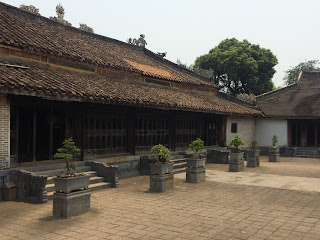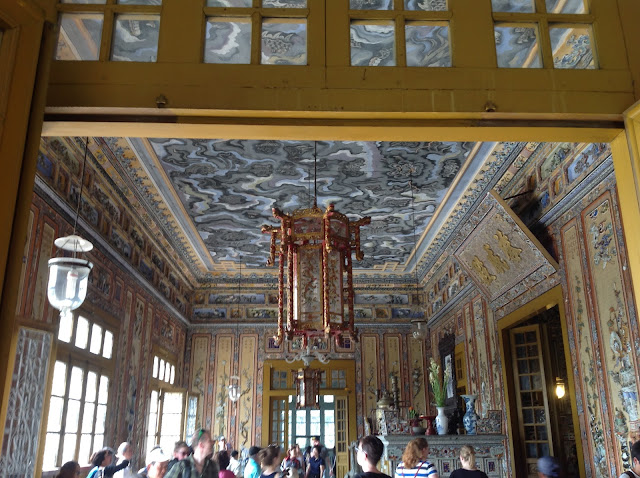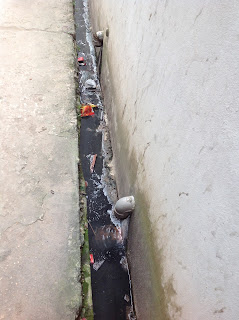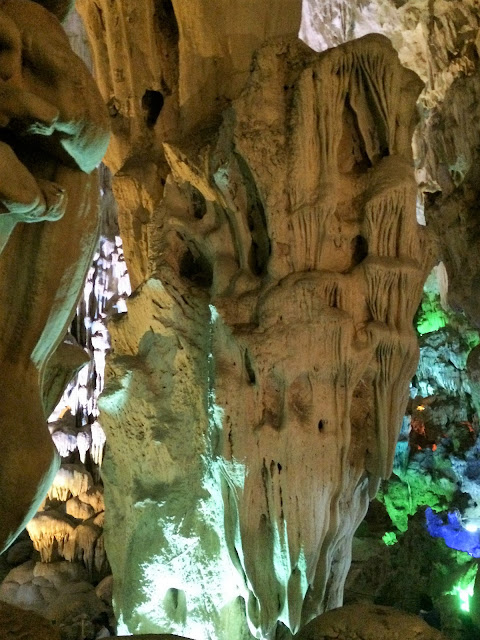Aloha again!
We visited a lot of "H" cities in Vietnam. The last blog ended at Hoi An - on the beach. This blog picks up with Hue and then moves on the Halong Bay- another world heritage site - and then Hanoi.
When we left Hoi An, we drove through Danang, stopping to see China Beach ( the R&R place for American soldiers during the war) and to photograph the Dragon Bridge which crosses the Han River. China Beach has LOTS of new resorts - some completed, some nearing completion, and some waiting to be built.
 |
If you look to the right of the dragon tail, in the distance behind the building, there is an "Eye Wheel" in Danang.
Will have to make that a priority on the next visit. |
Hue
Hue sits in central Vietnam and is on the Song Huong or Perfume River. I didn't find Hue the most attractive of cities, but I discovered that the reason we visited Hue was because of the ancient citadel in the city center and the tomb sites for the last Nguyen war lords. (We also discovered that this is the home of the North Face knock-offs in the street markets!)
The Citadel
Per my guide book, the Imperial Citadel still stands despite violent bombardment by the Viet Cong and the Americans between 1954 -1975. The Citadel covers 1,285 acres and is enclosed by a wall made of stone, brick and earth, measuring 26 ft. high, is 65 ft. thick and totals 6 MILES in total length. The Inner Zone of the Citadel is modeled after Beijing's Imperial City.
Insight Guides: Vietnam, pps 197 - 199.
Photos of the exterior wall and entrance gate:
Once inside the first gate----
 |
| The inside wall to the Inner Zone of the Citadel |
 |
| The grounds inside the inner zone. |
Photos of the interior buildings, courtyards, and detail from the roof decorations.
 |
| One of the exit gates. |
After the Citadel visit, we were on our own to wander around Hue. So my pal and I went shopping...
 |
| As Pat noted in his blog, "Tweedle Dee and Tweedle Dum", matching hats, matching sunglasses- for the grand total of $11. |
Thien Mu Pagoda, Tu Ducks Tomb, Kai Dinh's tomb
We headed down the "not-so-perfumey" Perfume River to visit the Thien Mu Pagoda. This pagoda is famous because in 1963, a monk from this monastery travelled to Saigon and burnt himself to death in protest to the repressive regime at the time. The car and his photo are on display in the museum behind the pagoda and the monastery.
 |
| The seven tiered pagoda, each level represents a different reincarnation of the Buddha. |
 |
An apprentice monk, or baby monk according to our guide, at work. Notice the swath of hair still on his head.
When he ready to commit, his head is completely shaved. |
 |
| Monastery dining hall |
 |
| CLM on the monastery grounds |
En route to the Tu Duc summer palace and tomb, we drove through a town that is famous for making incense and the Vietnamese hat.
 |
| Incense on display in an incense shop |
 |
| Incense on display in the center of town |
 |
| Hat making. To me, these hats would make great lampshades |
 |
| My travel pal Pat has a thing for hats..... |
Tu Duc's tomb is also his leisure palace; Tu Duc was the 4th Nguyen King and he began construction on his leisure palace/tomb in 1864 and it was finished in 1867. I liked the housing areas and all the doors that opened to patios. Unbelievable fresh air (albeit very warm) came through all the open doors.
 |
| The "informercial" about the tomb area |

 |
| cool lanterns in the hallways |

 |
| looking to the Library building photo below zooms in on the fish gargoyle |
 |
| Entering the tomb area |
 |
| Recycle ceramics embedded in the concrete or plaster |
 |
| overall view to tomb area |
We took a break from tombs and architecture to have lunch at a convent for Buddhist nuns. Lovely and peaceful in every respect. Every thing we ate was grown on site and the nuns were very kind in answering all manner of questions.
After our calm lunch, we were ready for the sensory overload of the last tomb of the day, Khai Dinh's tomb. This tomb/area took 11 years to complete and was finally completed in 1931. Everything about this tomb is sensational: the dragon staircases, the views from each level of the tomb area, , the dragon in the cloud painted ceilings, the colored glass murals on the walls, the bronze statue of Khai Dinh,
 |
| Entry all to the tomb area. The ceiling was painted by FOOT. Dragons in the clouds |
 |
| The lifesize bronze monument to the King, Khai Dinh |
 |
| Details of the column. Colored glass and ceramics |
 |
| Another cool lantern and a view of the "foot"painted ceiling |

Details of the wall murals/ceramics... what a way to recycle old glass and broken pottery.
After this unbelievable burst of color and design, I needed to find something for home and the only thing I found was this gigantic tea pot and cups and saucers- a great water element for my pool, but sadly no way to ship this.... Oh well. Think of the $$ I saved.
Halong Bay
From Hue, we flew to Hanoi (about 45 min) and then boarded a bus for a 2+ hour drive to the coast to Halong Bay- a UNESCO world heritage site. We boarded a boat for a cruise around the limestone islands and outcrops and then stopped to go through the caves at Halong Bay. Glorious spot and this area should be on everyone's bucket list! Get here soon as development is coming!!!
 |
| The view from the roof of our hotel |
 |
| The view from the roof of our hotel |
|
 |
| Our trusty boat for the morning cruise through the islands |
 |
| We shared the space with many other tourist boats. Imagine what will happen when this area is REALLY popular!! |
Many photos of the beautiful scenery below, sky was overcast most of the morning, so we didn't experience the turquoise blue color of the water. But---Just imagine canoeing or kayaking in this area!
 |
| The cock fighting rocks |
The parking lot for the entrance to the caves
The caves - three chambers filled with stalactites and stalagmites -- (stalactites hang tight to the top and stalagmites hang on with all the might to the floor). I have been to the Grotti di Frasassi in Italy and these caves are great, but not as large as the Italian ones. Plus, because it was not rainy season in Vietnam, no water was dripping from the ceiling to the floor. Another visit during rainy season.
 |
| Another informercial |
After a lovely day at Halong Bay, we drove to Hanoi - the last city on our Vietnam tour.
Hanoi
Hanoi is a big city with old temples, old quarters, new buildings and trendy coffee shops and a population of just under 7 million people. We walked around the older portion of the city and the street life and street vendors did not disappoint. We ended the day's tour with a water puppet show. GREAT fun!
 |
| Wiring --- like this on all the street corners! |
 |
| Enjoying life on a balcony- people watching...... |
 |
| Motorscooters- the mode of transportation all over Vietnam. |
 |
| Setting up for street dining. |
 |
| Street vendor |
 |
| More wires --- imagine if someone took bolt cutters and just cut a few wires...... |
 |
| Lunch |
 |
| Have a tea cup or a porcelain bowl |
 |
| The knife and scissor vendor doesn't have much business so time for a nap. |
 |
The "slipper" lady. The word for slippers or sandals in Russian in "Vietnamskas".
VERY APPROPRIATE WORD!!! |
 |
| French Bread Vendor! |
The color of this video may not be the best, but the water puppets and the splish splash of the dragons playing ball is fun to see!
Our last day in Vietnam, we visited two villages outside of Hanoi. The first village has Thay Pagoda; the second village -So, a typical village with a very successful rice noodle making business.
 |
| New house being built |
 |
| The fancy courtyard with mural on back wall |
 |
| Betel nuts for sale |
 |
| Lanterns and lantern posts along entry to the village |
 |
Looking across the pond to the Thay pagoda. There is also a water puppet theater in the pond--
the "white sheet" is the back of the puppet theater. |
 |
| The front of the water puppet theater -- town square in front. |
 |
| The Front of the Thay Pagoda faces the town square |
 |
| Covered Bridge coming into town square and pagoda |
 |
| Covered bridge leaving the pagoda and the square |

The rock wall and gardens in the pagoda courtyard had many minature pagodas and figures, orchids and bonzais. Really fun to see all the difference scenes.

One of the altars inside the pagoda.
 |
| Statues of the Buddha in different positions and periods in his life |
 |
| This urn was/is HUGE- love the offering of pomelos on the top |
 |
| Another view of the main altar with the statues of the Buddha at different times in his life |
 |
| Carved panel depicting heaven and hell |
 |
| Temple guard |
From the temple, we drove across the countryside to the village of So. Many of the older women are "betel nut" chewers; their mouths and teeth are black from the betel nuts.
 |
| My friend Pat enjoying a smile and a chat with one of the betel nut chewing ladies. |
This town has a mix of older houses, newer houses (skinny but tall as land is so expensive). The plumbing features still seem to empty into the streets and gutters. HMMM.
 |
| Street gutters.....hmmmm |
 |
| Village children having fun counting in English with Dan, one of our tour friends |
 |
| Village children- the little girl in pink has her slippers on the wrong feet!!! |
While wandering through the village alleyways/sidewalks, we came across a group of villagers putting an old chest freezer on the back of a motor scooter. The freezer was balanced on the back of the scooter and then, off the driver went- scooter and freezer - down the alleyway.
 |
| Amazing... one piece of rope, one old chest freezer, one motor scooter, one driver......all balanced |
THEN on to the noodle factory which was fascinating;
a) making the rice flour and water "goop", b) pouring the goop into the machine, c) the noodle mix becomes a flat surface as the machine sends the mix through steam and rollers and d) "voila" out come sheets of wet noodles.
 |
| The rice flour and water "goop" going into the pan, spreading thin as it rolls into the machine |
 |
| The noodle sheet making machine |
 |
| The wet noodle sheets coming out of the roller machine |
A short video clip of the machine at work:
The sheets of noodles are placed on bamboo drying racks. When the carts have about 25 drying racks, the workers race out to the fields and put the racks out to dry. (I wonder what happpens if there is a sudden downpour!) Then the dried sheets are brought back into the factory and cut into the skinny noodles we recognize in our markets.

The noodle sheets on bamboo racks drying all around the outskirts of the village
 |
| The cutting machine - taking the long sheets and making them into skinny noodles |
 |
| The finished noodles. on the cart ready to be packaged and then sent to markets. |
The almost three week adventure was wonderful. Thanks for letting me share the photos and the adventures. And now, ending one bucket list adventure, only opens up many many more.
Aloha!















 Details of the wall murals/ceramics... what a way to recycle old glass and broken pottery.
Details of the wall murals/ceramics... what a way to recycle old glass and broken pottery.















 Details of the wall murals/ceramics... what a way to recycle old glass and broken pottery.
Details of the wall murals/ceramics... what a way to recycle old glass and broken pottery.




































































































